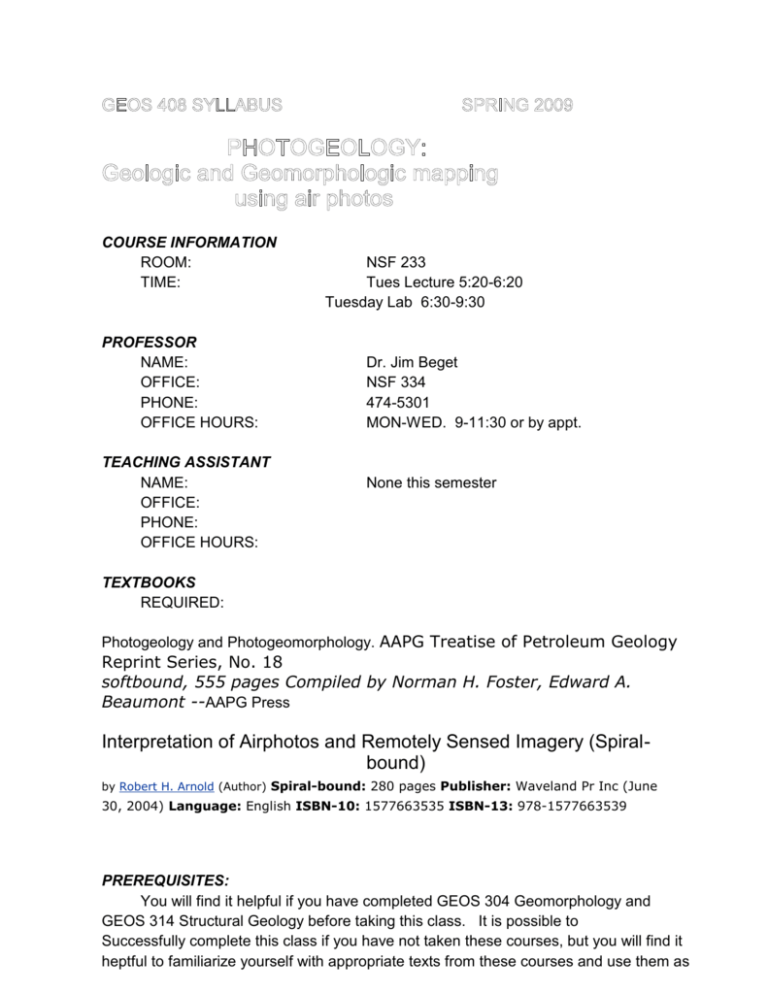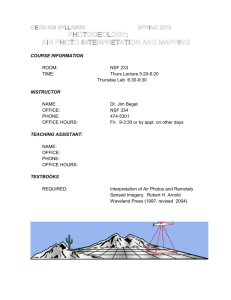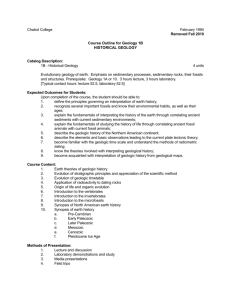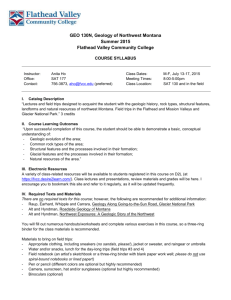teaching assistant
advertisement

COURSE INFORMATION ROOM: TIME: PROFESSOR NAME: OFFICE: PHONE: OFFICE HOURS: TEACHING ASSISTANT NAME: OFFICE: PHONE: OFFICE HOURS: NSF 233 Tues Lecture 5:20-6:20 Tuesday Lab 6:30-9:30 Dr. Jim Beget NSF 334 474-5301 MON-WED. 9-11:30 or by appt. None this semester TEXTBOOKS REQUIRED: Photogeology and Photogeomorphology. AAPG Treatise of Petroleum Geology Reprint Series, No. 18 softbound, 555 pages Compiled by Norman H. Foster, Edward A. Beaumont --AAPG Press Interpretation of Airphotos and Remotely Sensed Imagery (Spiralbound) by Robert H. Arnold (Author) Spiral-bound: 280 pages Publisher: Waveland Pr Inc (June 30, 2004) Language: English ISBN-10: 1577663535 ISBN-13: 978-1577663539 PREREQUISITES: You will find it helpful if you have completed GEOS 304 Geomorphology and GEOS 314 Structural Geology before taking this class. It is possible to Successfully complete this class if you have not taken these courses, but you will find it heptful to familiarize yourself with appropriate texts from these courses and use them as needed during the laboratory exercises. Some students find it helpful to buy an inexpensive geologic glossary or dictionary. A working knowledge of geometry and algebra are also important. If you are color-blind, or unable to view objects stereoscopically, you will have difficulties with some of the laboratory exercises. In our first week’s laboratory we will test ourselves for color blindness, and practice viewing objects in stereo (i.e. in three dimensions). If you have any problems with color blindness or ability to visualize in 3-D during the first laboratory session, please discuss this with me. COURSE OBJECTIVES 1. You will gain experience in recognizing and interpreting geomorphic landforms on aerial photos. 2. This course will train you to recognize different lithologies and geologic structures on aerial photographs. You will learn about the influence of vegetation and weathering in different climatic zones on aerial photo mapping. 3. You will learn to make geologic maps from aerial photographs. The laboratory sections will cover the selection of units for unit, the. essential elements of all geologic maps. You will also learn about the mechanics of aerial photography and stereoscopy. There will be a brief introduction to methods for quantitative analyses of maps. 4. We will briefly survey the use of satellite imagery for geomorphic studies and regional photogeologic mapping. 5. We will introduce the use of aerial photographs in field mapping. COURSE DESCRIPTION This course is divided into two parts. The first few weeks will be devoted to introductory lectures and exercises which will introduce you to aerial photos and geologic maps. We will cover the mechanics of aerial photography and stereoscopic viewing. The laboratory will move to a series of exercises that involve mapping of progressively more complex structures and geomorphic features. Some laboratory exercises will involve completing mapping problems of various types and scales, and answering questions about geologic relations and history you interpret from your photo interpretations. The aerial photos will usually be from your text. In some cases you will map structural geology, while other exercises will emphasize interpretations of natural processes and geomorphology. The second part of the class will concentrate on photogeologic mapping of complex areas and the use of photogeologic methods on special topics. We will do 1-2 lab exercises on difficult photo problems, including remotely sensed imagery. Students will then spend several weeks working on an independent mapping project using either their own photos, on a project provided by the instructor, or on a problem of their choice using photos available at the GEODATA CENTER in the GI. Students may work singly or in groups with groups required to map a larger area. Upon completion of the maps, students will make oral presentations describing the regional geology of the area they have mapped at the next to last class meeeting. Short written reports will also be completed on the final mapping problems. COURSE FORMAT LECTURE: LABORATORY: READINGS: EXAMINATIONS: Each class session will begin with a lecture covering technical aspects of photogeologic mapping. Labs will deal with progressively more difficult photogeologic mapping problems. Readings from the text will be assigned weekly, and will contain information relating to the lecture and the lab work. Some additional, supplemental readings may also be assigned. Only one examination will be held, in the middle of the term. The exam will be based on lectures and lab exercises, and will include photo interpretation of a series of images. GRADES: The examination will be worth 33% of the grade. The final project (map & report) will be worth an additional 33% and lab exercises during the term will make up the final 33%. DUE DATES: In general, it will be possible to complete work during the weekly labs. However, if a mapping exercise takes you a bit longer, or if you have a conflict with the lab, exercises will be accepted up to the end of the next class. No weekly labs will be accepted after this deadline. FINAL PROJECT: The final project is an important part of this class. You are responsible for picking an interesting area and problem to map. There is complete photo coverage of Alaska in the GI, so you can work on just about any Alaskan problem you want. Its a good idea to start thinking and planning your project before the end of the term. In past classes people have selected areas that they mapped or visited during geologic work the previous summer. Some students maps sites where they have a cabin or a mineral claim. You can work alone, but groups of 2-3 are also acceptable. Groups must map proportionally larger areas. Sean or I will happily suggest some possible final projects to you if you need an idea. Each project should have a theme...(i.e. glacial geology, or active fault scarps, o jointing patterns, etc.) but all geology in the photos you select must be mapped. All final project topics must be cleared in advance with me. FOOD:* Evening classes can be highly enjoyable… however there is a small problem with the class running through the dinner hour.* If you want to eat during the lecture portion of the class it is ok with me. Please feel free to bring food to class, and to eat it during the first hour of the class. I don’t want food around the lab materials, so if you want to eat during the last 3 hours of the class, please leave classroom during the lab period and go upstairs and use the microwave and have a bite there. *I’ll bet this is the first syllabus you ‘ve ever seen with a section on food. Speaking of food……. QuickTi me™ and a T IFF (Uncom pressed) decom pressor are needed to see t his pict ure. Quic k Ti me™ and a T IFF (Unc om pres s ed) dec om pres s or are needed to s ee t his pic t ure. QuickTime™ and a TIF F (Uncompressed) decompressor are needed to see this picture. Every year some students become nauseous during the lab portion of this class. This occurs because of eye strain . This illustrations above show typical GEOS 408 students working on their final project. Note how cross-eyed they have become from looking down stereoscopes too long!!!!!! Its true….you can make yourself a little bit sick in the lab from crossing and uncrossing your eyes to look down the scopes, particularly if the original flightlines weren’t parallel or the photopairs aren’t aligned properly. If you begin to feel nauseous, just stop working, get up, walk around and get some fresh air. Don’t let yourself get even close to feeling like the people in the above illustration look...take a break, drink a coke, go for a walk outside. *Please note that the nausea warning refers to the labs only....the lectures are guaranteed NOT to make you sick, so don’t miss them! DATE (WEEK OF) 1-27 2-3 2-10 LAB/LECTURE Introduction/aerial photos/stereoscopes & stereovision Begining photo analysis/drainage patterns Geologic maps /volcanic landforms 2-17 Tectonism/active faulting/folds 2-24 Simple structure 3-3 ………..Glacial Geology/Surfical geologic mapping =3-9 to 3-13=============spring break========================== 3-17 Fluvial/Desert/ Periglacial surficial features 3-24 …………..Midterm examination 3-31 ………..Mapping complex structure (practice project) 4/7 ……… Remote sensing/Landsat/Radar 4-14 MEET AT GI PHOTO ARCHIVES--begin work on projects 4-21 work on final projects 4-28 FINAL PROJECTS DUE----in class reports given 5-4 or 5-7 FINAL PRACTICAL EXAM: Field mapping with aerial photos (field trip...wear mud boots) The Final Exam period is scheduled for 5 pmTuesday May 7---The final exam will be a “lab practical” involving using air photos in field work. In addition, the final papers for the lab project will be due by 5 pm, May 7. NOTE: This schedule is subject to revision if class conflicts arise during the term.







